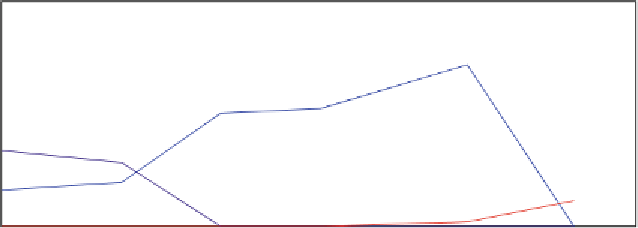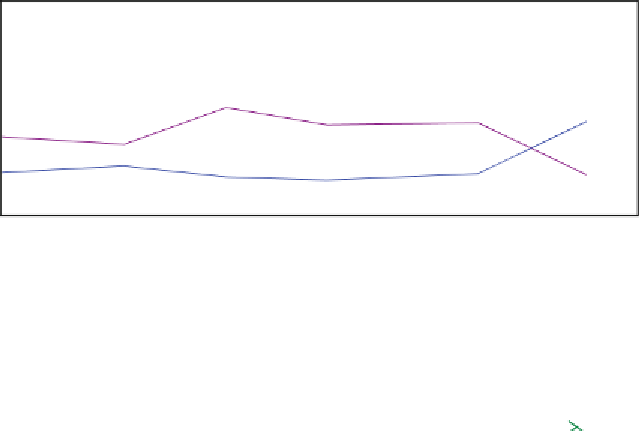Biomedical Engineering Reference
In-Depth Information
a
. - pH 6
120
Bioaugmented
100
80
60
40
20
0
0
3
6
9
b
. - pH 7
120
100
80
60
40
20
0
0
30
60
90
Time (Days)
TCE
cis
-DCE
VC
Ethene
Figure 4.3. Results from microcosm testing performed with solids and groundwater from a TCE-
contaminated site (Hunter Army Air Force Base, Georgia). Half of the microcosms were incubated
at the initial pH of the site groundwater (pH 6.0), and half were adjusted to neutral pH (pH 7.0). A
commercial bioaugmentation culture (SDC-9
™
, Shaw Environmental, Inc., Lawrenceville, New
Jersey) was added to both sets of microcosms after 59 days. Results showed no dechlorination in
the pH 6.0 microcosms until bioaugmentation (Panel A), with slow development of complete dechlo-
rination ability afterwards. In the pH-adjustedmicrocosms (Panel B), partial dechlorination was rapid
before bioaugmentation, and complete dechlorination was observed soon after bioaugmentation.
characterized by important heterogeneities, greater scales and dynamic features that are
difficult to reproduce in the laboratory. As a result, researchers have long realized that
biodegradation rates in the field may differ from microcosm results (e.g., Spain et al.,
1984
),
but also microcosms may not always predict the need for bioaugmentation accurately. For
example, Lu et al. (
2009
) showed that microcosms did not always exhibit complete dechlorina-
tion, even when the samples were taken from wells with high concentrations of ethene in the
groundwater.
These results illustrate the strengths and limitations of microcosm testing. Under controlled
conditions, it is possible to demonstrate with reasonable certainty whether bioaugmentation is
necessary, and to diagnose the reasons for disappointing performance. But microcosm testing
requires time and money, and it may not provide accurate rate estimates.
4.7.2 Field Testing
Field testing is obviously preferable for many purposes, e.g., estimating degradation rates
under real-world conditions. A variety of field test methods have been developed and used to
assist in evaluating biostimulation. These are described in the following sections.




























































































Search WWH ::

Custom Search